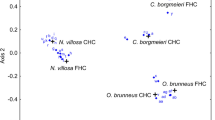Summary
The cues used for orientation during homing were examined in ants from 3 subfamilies, i.e.Atta laevigata, Acromyrmex octospinosus, Acromyrmex rugosus, Trachymyrmex urichi; Ectatomma ruidum andPseudomyrmex termitarius, by means of a Y-maze experiment. The results showed that ants use various cues for orientation through a maze. For each ant species, the cues may be classified in a kind of species-specific hierarchy according to their importance during homing. In addition to visual and chemical orientation, empirical evidence supporting the existence of a topochemical is presented.P. termitarius uses a kinesthetic sense for orientation. Learning of the cues in the laboratory is not directly related to the respective hierarchy used for orientation through a maze by each species, but seems to be inversely correlated with the social complexity of the species. The number of cues used for orientation correlates directly with the social complexity of the species. A divergent evolutionary development of orientation strategies, even among closely related species, is proposed.
Resume
Les modalités d'orientation utilisées dans le retour au nid sont étudiées au moyen de labyrinthes en Y dans 3 sous-familles de fourmis:Atta laevigata, Acromyrmex octospinosus, Acromyrmex rugosus, Trachymyrmex urichi, Ectatomma ruidum etPseudomyrmex termitarius. Les résultats montrent que les insectes utilisent plusieurs stratégies pour s'orienter dans le labyrinthe. Pour chaque espèce, les différentes modalités sont classées par ordre d'importance dans leur utilisation lors du retour au nid. Outre les repères visuels et chimiques, apparaît l'existence d'une orientation topochimique.P. termitarius utilise dans son orientation un sens kinesthétique. L'apprentissage des repères par la fourmi au laboratoire n'est pas en relation directe avec la hiérarchie des modalités d'orientation utilisées par chaque espèce dans le labyrinthe et apparaît en corrélation inverse avec la complexité sociale des espèces; le nombre de repères utilisés augmente par contre avec le degré évolutif de l'insecte. Une évolution divergente de ces stratégies d'orientation, même dans des espèces proches phylogénétiquement, est proposée.
Similar content being viewed by others
References
Bernstein S., Bernstein R.A., 1969. — Relationship between foraging efficiency and the size of the head component brain and sensory structure in the red wood ant.Brain Res., 16, 85–104.
Bethe A., 1898. — Durfen wir den Ameisen und Bienen psychische Qualitaten zuschreiben?Pflugers Archiv fur die Gesamte Physiologie, 70, 15–100.
Carthy J.D., 1951. — The orientation of two allied species of british and I and II.Behaviour, 3, 275–318.
Dumpert K., 1978. — Das Sozialleben der Ameisen,Paul-Parey Verlag, Berlin-Hamburg.
Forel A., 1928. — The social world of the ants compared with that of man, 2 vols,Putnam's London, 551, 445 pp.
Henquell D., Abdi H., 1981. — Influence respective des repères visuels et des repères chimiqus dans l'orientation deFormica polyctena au cours de l'exploration d'une source de nourriture.Insectes Soc., 28, 47–66.
Hölldobler B., 1980. — Canopy orientation: A new kind of orientation in ants.Science, 210, 86–88.
Jaffe K., 1980. — Communication among workers of leaf-cutting ants.PhD thesis, University of Southampton, England.
Jaffe K., 1983. — Chemical communication among workers of leaf-cutting ants. In:Social Insects in the Tropics, Jaisson Ed. Univer. Paris Nord,2, 165–180.
Jaffe K., 1984. — Negentropy and the evolution of chemical recruitment in ants.J. theor. Biol., 106, 587–604.
Jaffe K., 1987. — The evolution of territorial behaviour and nstmate recognition systems in ants.Experientia suppl., 54, 295–311.
Jaffe K., Howse P.E., 1979. — The mass recruitment system of the leaf-cutting antAtta cephalotes.Animal Behaviour, 27, 931–939.
Jaffe K., Perez E., 1989. — A comparative study of brain morphology in ants.Brain Behav. Evol., 33, 25–33.
Jander R., 1963. — Insect orientation.Ann. Rev. Entomol., 8, 95–114.
Pieron H., 1904. — Du rôle du sens musculaire dans l'orientation de quelques espèces de fourmis.Bull. Inst. General Psychol., 4, 168–186.
Rosengren R., 1977. — Foraging strategie of the wood antFormica polyctena I. retention of fidelity to routes during nocturnal foraging and through hibernation period.Acta Zool. Fennica, 149, 1–30.
Schneirla T.C., 1953. — Modifiability in insect behaviour. In:Insect Physiology, Roeder Ed., John Wiley & Sons, N.Y. pp. 723–747.
Shone H., 1984. — Spatial Orientation.Princeston seres in Neurobiology and Behavior, Princeton University Press.
Topoff H., Lawson K., 1979. — Orientation of the army antNeivamyrmex nigrescens: Integration of chemical and tactile information.Animal Behaviour, 27, 429–433.
Vilela E., Jaffe K., Howse P.E., 1987. — Orientation on trails by workers of the leaf-cutting antsAtta cephalotes, Atta laevigata andAcromyrmex octospinosus.Animal Beehaviour, 35, 1443–1453.
Vilela E., Jaffe K., Lucia T., 1987. — O fenomeno da comunicaçâo nas formigas cortadeiras.Ciencia Hoje, 6, 26–30.
Vowles D.M., 1950. — Sensitivity of ants to polarized light.Nature, 165, 282–283.
Vowles D.M., 1954. — The orientation of ants I and II.J. Exper. Biol., 31, 341–375.
Wehner R., 1982. — Himmelsnavigation bei Insekten.Neupahrsblatt der Naturforschenden Gesellschaft in Zurich, 123 pp.
Wilson E.O., 1971. — The Insect Societies.Harvard Univer, Press, Cambridge, Mass. 548 p.
Author information
Authors and Affiliations
Rights and permissions
About this article
Cite this article
Jaffé, K., Ramos, C., Lagalla, C. et al. Orientation cues used by ants. Ins. Soc 37, 101–115 (1990). https://doi.org/10.1007/BF02224024
Received:
Accepted:
Issue Date:
DOI: https://doi.org/10.1007/BF02224024




